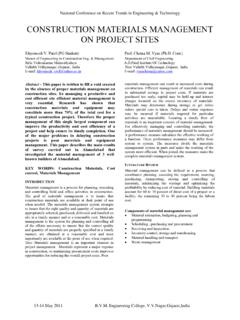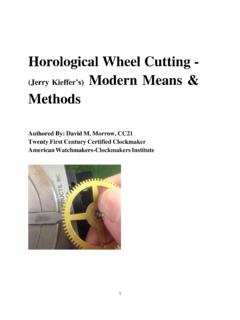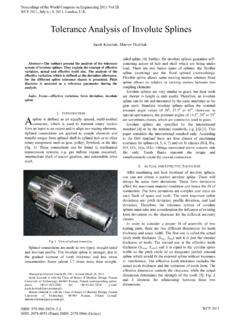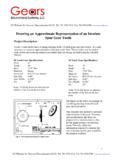Transcription of A parametric modeling of spur gear using …
1 A parametric modeling of spur gear using ProEngineerAnand B. Rathod*1, Vinay J. Patel#2, #3*Mechanical Engineering Department, Birla Vishvakarma Mahavidhyalaya, , Gujarat, India#Associate Professor, Mechanical Department, Birla Vishvakarma Mahavidhyalaya, , Gujarat, Teeth of spur gear have commonly involute profile. The circle from which the involute is derived is called the base circle. The pitch circle diameter of gear has a relation with module of spur gear and number of teeth. Similarly, other dimensions of spur gear have direct or indirect relation with module, number of teeth and pressure angle. In other words, parameters like module, number of teeth and pressure angle decide the shape and size of a spur gear . A procedure to make parametric model of spur gear using ProEngineer Wildfire is described in this are common components in many mechanical designs, but the surface profile of the gear teeth is relatively difficult to draw accurately.
2 Since gears are normally either purchased components, or else fabricated with standard cutters, they are often not drawn in exact detail, but simply as circular blanks without the teeth cut out. One may require detailed finite element analysis of a gear set, or perhaps may need to fabricate gears with a rapid prototyping machine. Either of these will require an exact CAD model of the tooth geometry, and approximate methods will not always meet the TERMINOLOGY(1) Pitch circle: An imaginary circle that contacts the pitch circle of any other gear with which it is in mesh.(2) Pitch diameter (D): The diameter of the pitch circle.(3) Number of teeth (N):The number of teeth on the gear .(4) Diametral pitch (P): The number of teeth of a gear per inch of its pitch diameter.(5) Module (m): The ratio of pitch diameter to the number of teeth. It is reciprocal of the diametral pitch.
3 The pitch diameter is specified either in inches or millimeters.(6) Pressure angle (a):The angle through which forces are transmitted between meshing gears. It is either or 20 . It defines the geometry of the gear tooth and also determines the diameter of the base circle.(7)Addendum (a):The Radial distance from the pitch circle to the top of the gear tooth.(8)Dedendum (b):The Radial distance from the pitch circle to the bottom of the tooth gear Terminology of spur Gear13-14 May 2011 Engineering College, ,Gujarat,IndiaNational Conference on Recent Trends in Engineering & involute CURVEIt is known that involute gears are the most widely used in practice, being preferred over cycloidal and circular profile gears. The involute gears have the active flanks of their teeth shaped as involute curves of a common circle, called base circle. The involute of a circle is obtained by attaching an inextensible string to this given circle, and tracing its free end as it is wound or unwound onto the base circle.
4 Fig. 2illustrates this concept, where BT represents the string, while the involute curve is the locus generated by the free end point T of the The involute Curve of a Circle of Radius rbThe following scalar equations are used to define involute :CCrCrXbb cossinCCrCrYbb sincos 1) involute of spur gear is drawn from its base circle (refer Table 2 for relation of radius of base circle). This involute profile is either extended or trimmed to root circle (refer Table 2 for the relation). The radius of root circle is less than that of base circle for number of teeth (Z) is less than or equal to 42[3]. To complete the profile of tooth in ProEngineer, the involute should be extended or trimmed. Hence, there should be two parametric models for the spur gear : one for less than or equal to 42 teeth and other for greater than 42 teeth. Here, this issue has been approached in a different way.
5 A spline is drawn which joins the center of base circle and six point on involute profile (Fig. 5). It is also compared that there is no difference between involute profile drawn by this method and spline drawn by joining six points on involute . THE spur gear IN PRO/ENGINEERF irst, open a new part file and create the basic gear parameters as shown in using Tools Parameters. These basic gear parameters determine all other parameters that define the gear tooth profile (or alternatively, the profile of the spaces between the gear teeth). The other gear parameters, shown in Table 2, are defined in terms of relationship to the basic parameters (Fig. 3) using Tools Relations. Basic gear parameterVariable NameVariable TypeValueDescriptionMReal Number2 ModuleZInteger25No. of teethAReal Number20 Pressure Table of gear parameters and Pitch of the teeth on a straight generative m>1hf = *melse hf = *mDedendum *Z/2 Radius of the pitch + haRadius of the outer hfRadius of the root *cos(a)Radius of the base * of the root concave *( sin(C * ) -cos(C * ) * C* )X coordinates of the involute tooth profile *(cos(C * ) +sin(C * ) *C * )Y coordinates of the involute tooth * a * / 180 Radius of the osculating circle of the involute curve, on the pitch 1cos12 aAngle of the point of the involute that intersects the pitch circle.
6 (tan1 Rotation angle used for making a gear symmetricto the ZX plane 13-14 May 2011 Engineering College, ,Gujarat,IndiaNational Conference on Recent Trends in Engineering & Defining Part RelationDefining Axis and Datum PlaneFor creating involute profile, X, Y, and Z axes are created first and then the datum planes using these axes. The X axis is an intersection between Top and Front planes. Y and Z axes are also created as specified in Table 3. Then datum planes are created which pass through the axis and make an angle with the primary reference planes as shown in Table 3. This angle is the rotation angle that makes the gear symmetric. Selection of Reference PlaneAxis /Datum planeReference plane 1(Select)ValueReference plane 2(Select)X_AXISTop plane-Front planeY_AXISF ront plane-Right planeZ_AXISR ight plane-Top planeDATUM_1 Right plane(offset)abs(phi)Z-axis(through)DATU M_2 Datum1(offset)90oZ-axis(through)DATUM_3 Right plane(offset)180/ZZ-axis(through)Definin g Datum Points Now, click on sketch tool and select Front plane as sketching plane and Datum1 as reference with right orientation.)
7 Createsix points in first quadrant and give following relations in Tools Relations. The resultant sketch is shown in Fig. 4. These points are created parametrically for different values of C. Note: Change the name of all dimensions as per requirements. Click on dimension and press the tab properties and *(sin(0*PI) - cos(0*PI)*0*PI)Y1=rb*(cos(0*PI) + sin(0*PI)*0*PI)X2=rb*(sin( *180) - cos( *180)* *PI)Y2=rb*(cos( *180) + sin( *180)* *PI)X3=rb*(sin( *180) - cos( *180)* *PI)Y3=rb*(cos( *180) + sin( *180)* *PI)X4=rb*(sin( *180) - cos( *180)* *PI)Y4=rb*(cos( *180) + sin( *180)* *PI)X5=rb*(sin( *180) - cos( *180)* *PI)Y5=rb*(cos( *180) + sin( *180)* *PI)X6=rb*(sin( *180) - cos( *180)* *PI)Y6=rb*(cos( *180) + sin( *180)* *PI) Defining Datum PointDrawing InvoluteTake front plane as sketching plane and Datum1 as reference to sketch the involute . In sketcher, with these preferences, draw a spline passing from origin of PRT_CSYS_DEF and points PNT0, PNT1, PNT2, PNT3, PNT4, PNT5.
8 Mirror the spline with respect to center line (which drawn with reference datum plane datum 3). Then sketch two circles with following relations corresponding to outer diameter of gear blank and the root circle diameter. The resultant sketch is shown in Fig. =2 * raR_F = 2* rf13-14 May 2011 Engineering College, ,Gujarat,IndiaNational Conference on Recent Trends in Engineering & Sketching the InvoluteFinishing spur GearCreate the gear blank by extruding the circle of diameter corresponds to the outer diameter of gear . Since only the portion of involute curve above the root circle is required, trim the lower portion of spline and extrude it to cut the gear blank(Fig. 6). Extrude Cut the involute profileCreate the rotational pattern of the cut portion of the gear with number of copies equal to the number of teeth. Fillet the gear teeth at the root diameter using round tool to reduce the root fillet stress.
9 Final parametric Model of spur GearVI. CONCLUSIONThe parametric model is capable of creating spur gears with different modules and number of teeth by modifying the parameters and regenerating the model. Sets of gears having the same module and pressure angle can be created and assembled together. It is possible to carry out finite element analysis such as contact stresses between gear teeth pair and effect of root fillet radius on the root stresses. VII. REFERENCES[1] Gitin M. Maitra, Hand Book Of gear Design ,Tata McGraw Hill Publishing Company Limited.[2] Design Data Book, PSG Tech, 2nd edition, 2001.[3] Petru-Aurelian Simionescu, Interactive involute gear Analysis And Tooth Profile Generation using Working Model 2D , AC 2008-1325, University of Alabama at Birmingham, 2008.[4] Faydor L Litvin, gear Geometry and Applied Theory , Cambridge University, 2nd edition.
10 [5] Rixin Xu, Finite Element modeling And Simulation On The Quenching Effect For spur gear Design Optimization , University of Akron,August-2008.[6] Mike Renfro, modeling gear Teeth in Pro/Engineer Wildfire , May-2010.[7] Fang Feng, Hui Pan, Guojun Hu, Pro/E Based parametric Design of spur Gears , Advanced Materials Research Vols. 201-203 (2011) pp May 2011 Engineering College, ,Gujarat,IndiaNational Conference on Recent Trends in Engineering & Technology








